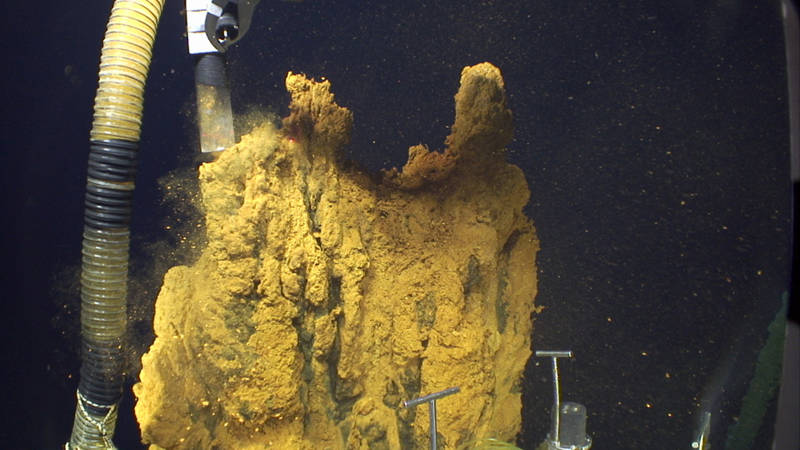
By Heather Fullerton - Western Washington University
December 20, 2014

Jason deploys a settling plate sampling device at one of the Urashima chimneys. Image courtesy of Submarine Ring of Fire 2014 - Ironman, NSF/NOAA, Jason, Copyright WHOI. Download larger version (jpg, 796 KB).
Our last Jason dive was to revisit the Mariana southern back-arc. The goal for this dive was to sample the tall chimney known as Golden Horn at Urashima vent field and to retrieve sampling devices left at Snail Vent. On this dive, we had many science objectives, all focusing on these locations, with each objective addressing a different aspect of the environment. Late in the dive, the transit from Urashima to Snail was cancelled due to weather so only the objectives at Urashima were met.

The scoop sampler allows the microbiologists to collect bulk samples of microbial mat, maintaining the integrity of the substrate the bacteria create and live within. Image courtesy of Submarine Ring of Fire 2014 - Ironman, NSF/NOAA, Jason, Copyright WHOI. Download larger version (jpg, 860 KB).
My focus is on the marine iron-oxidizing bacteria (FeOBs), the Zetaproteobacteria. These bacteria are ecosystem engineers and at Golden Horn they engineered a 13-meter (~42 feet) tall tower. The chimney was our first stop.
To examine this site, we used a variety of tools to determine the chemistry of the vent effluent and to collect samples of microbial mat. The vent effluent contains dissolved components such as iron and carbon dioxide, which are just what the FeOBs need to live. The carbon dioxide is converted into usable carbon compounds, such as DNA and sugars, using energy gained from the production of rust. In the process, the soluble iron in the vent effluent is oxidized into insoluble iron hydroxides.
At this chimney, we took samples from the top, middle, and the bottom. We sampled the microbial population and vent fluids, and recorded the temperature at each location. The vent fluid cools as it goes higher in the chimney. The highest temperature was 84°C (184°F) at the base and only 17°C (63°F) at the top, a drop of 67°C.

The Bio-Mat sampler allows the scientists to gather just the top layer of the mat, where it is believed all the active microbes live. Image courtesy of Submarine Ring of Fire 2014 - Ironman, NSF/NOAA, Jason, Copyright WHOI. Download larger version (jpg, 882 KB).
To collect the microbes, we used the Bio-Mat, scoop, and slurp (suction) samplers. The Bio-Mat sampler allows us to gather just the top layer of the mat. We think this is where all the active microbes live. The concentration of oxygen and iron is just right to allow the FeOBs to grow. When they do grow, they produce different mat styles. On this chimney, we observed lots of fluffy mats in direct hydrothermal vent flow as well as older crusty mat out of the direct flow.
The other samplers are also invaluable tools, allowing us to collect bulk samples of microbial mat. These samples tend to have more variety of microbes present, and are populated by microbes growing on the leftovers of the FeOBs.

The slurp sampler is used to collect bulk samples of microbial mat and larger organisms, such as shrimp, that live on and within the microbial mat structure. Image courtesy of Submarine Ring of Fire 2014 - Ironman, NSF/NOAA, Jason, Copyright WHOI. Download larger version (jpg, 744 KB).
At hydrothermal vent systems, the effluent chemistry drives the biology. To determine the chemistry of the vent fluid, samples were collected with the Hot Fluid Sampler (HFS for short, but affectionately referred to as “the Beast”), gas-tight samplers, and majors water samplers. Analysis of these samples by geochemists will tell us what types and the amount of specific chemicals are available for the microbes.
Fluid was also gathered with a modified Bio-Mat sampler. This modification allowed us to preserve the soluble iron fraction at the site for later analysis. This analysis is currently underway and will tell us how the iron concentration changes as we sampled up the chimney.
Goldern Horn Chimney at Urashima Vent. Video courtesy of Submarine Ring of Fire 2014 - Ironman, NSF/NOAA, Jason, Copyright WHOI. Video produced by Saskia Madlener. Music by Charlie Brooks. Download (mp4, 29.0 MB)